From The CRPG Addict
SSI began as a wargame company, and their best games–principally the Gold Box series and the Wizard’s Crown series–have always reflected those roots. Nonetheless, by 1992, the company seemed to be on a mission to dominate, or at least compete in, every RPG sub-genre. Eye of the Beholder and its sequel were their answers to the first-person, real-time category, while Shadow Sorcerer took inspiration from British axonometric titles. Neverwinter Nights had virtually no competition online, and they were entering the console realm with Dungeons & Dragons: Warriors of the Eternal Sun. The company’s streak of 22 published RPGs between 1991 and 1994 has never been broken on the personal computer.
 |
| Character creation even has some Ultima IV-style questions. |
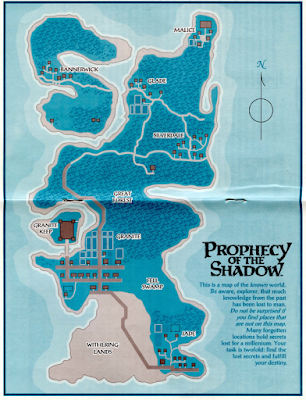 |
| The game map shows a small world. I already explored the northwest island. |
 |
| An NPC delivers part of the backstory. |
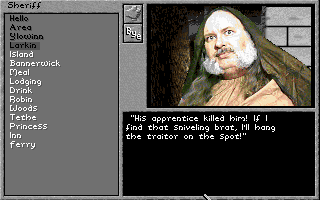 |
| “Yeah! I hope you find . . . him!” |
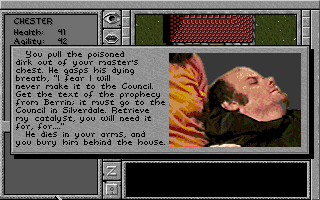 |
| The main character’s master dies in the opening scenes. |
 |
| A little FMV upon entering the inn. |
A row of icons–all, blessedly, with keyboard equivalents–defines how you interact with the world: look, attack, cast a spell, enter, drop, search, use, give, and rest. “Search” on Larkin’s door mat revealed an iron key to his house, but all I can do there is spend the night.
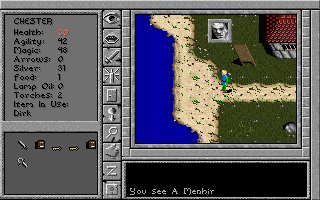 |
| Using the L)ook command–and learning a new piece of vocabulary. |
As I began the game, the passages through the forest around Larkin’s house naturally guided me to his neighbor, Berrin, who related that rumors have already spread that I killed Larkin. He gave me the key to Larkin’s workshop but otherwise wouldn’t help me (including giving me the prophecy) until I could prove my innocence. Behind Berrin’s house, incidentally, are two gravestones–his wife and son–both “killed by guardsmen.” I wonder if that bit of backstory will later come out.
Larkin’s workshop was accessed through an underground hatch near the house. There, I found a book of spells and a “lead catalyst.” You have to be holding a catalyst in your hands to cast a spell, and I guess lead is the lowest-level catalyst. The book had four spells: “Incendiere” is a basic fire blast that strikes one target; “Curare” is a healing spell; and “Memoria” and “Repetere” are a pair of mark/recall spells that let you designate a point and later warp back to it.
Using the game map as a guide, I eventually made my way to town, where I found about half a dozen NPCs, including some generic “peasants.” You converse by selecting keywords on the left side of the screen. As the NPCs respond, more keywords appear. Today, the local news was that the sheriff had caught Robin One-Eye, a famed bandit whose gang lives in the woods north of town. I was able to visit Robin One-Eye in jail but he just taunted me.
 |
| Getting lore from a local. Where did a bunch of programmers get access to so many actors who look like unwashed peasants with bad facial hair? |
I also heard some talk of Larf the Terrible, a gnome wizard who lives in a tower to the east. There was a note in Larkin’s workshop that a circle of mages expelled Larf for necromancy. I suspect that either Robin or Larf is responsible for Larkin’s death, and I’ll somehow need to prove it to get off the island.
The local shop had some weapons and other items that were outside my price range, although the innkeeper was willing to pay me 10 silver for odd jobs. I repeated this option about 8 times before he finally said he had nothing more for me to do. I bought a sling and a torch but spent most of my money on food.
Outside of town, I started encountering bandits. Attacking is a matter of hitting “A” (or the attack button) and then moving the cursor to your foe. If you have a melee weapon equipped, you can only target the 8 squares around you. (Well, technically you can target your own square, but the game just admonishes you not to attack yourself.) If you have a missile weapon, you can aim anywhere in the visible window. Missile weapons are tricky because enemies will typically move out of the square before the missile reaches them, meaning that you really want to attack the square in the direction they’re going. It strikes me that missile weapons are going to be mostly useless in this game. There simply isn’t enough distance in the view window, and enemies close the gap too fast.
You can cast a spell instead of attacking by using the spell catalyst–or, if it’s already equipped, hitting the M)agic button. At the outset, I only had “Incendiere,” which kills most enemies in a couple of castings, but two castings cost 20 magic points out of the 45 I started with.
If you choose to fight with a weapon, your health occasionally goes up a point. If you cast spells, your magic pool occasionally goes up a point. This is the game’s approach to “character development.”
 |
| My health increases as I kill a bandit. |
Slowly, I explored the rest of the island. It turned out there were two major indoor areas to explore: the bandit camp and Larf’s tower. You need a rope from the former to access the latter. I needed a password to enter the bandit camp, which required me to trudge back to town and buy Robin One-Eye a bottle of white zinfandel before he would tell it to me: ZINFANDEL.
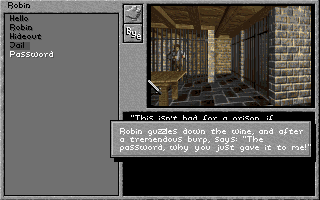 |
| Why does zinfandel have such a bad reputation? I rather like it. |
The bandit camp was one small level and one large level. I had to kill a bunch of bandits. I rather like the game’s search function. If you wander over to a chest, a dead body, or just an interesting area, you hit S)earch, and the game tells you what you find. It’s rather tolerant in its distance allowance, so you don’t have to hit the command every step. A lot of what you find are notes, journals, and other writings that flesh out the game’s lore.
The bandit camp held a few healing potions, a rope, a rapier (better than the starting dirk), a magic potion, and several black potions. The black potions are acid that damage you when you drink them, so I’m not sure what good they do. Late in the dungeon, I fought and killed a “mage killer,” who was carrying a “death warrant” for Larkin.
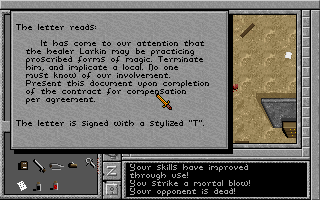 |
| The “T,” of course, probably stands for “Tethe.” |
A book called The Joy of Pies held a treasure map that directed me to a specific square from one of the stone heads on the island. There, I found a chest with several pieces of jewelry.
By now, I was running up against the inventory limit, which dogged me the rest of the session. It became clear that you want to drop most items as soon as their utility is done, including keys and notes. Actually, a better idea is probably selling them to the general store, because the store keeps sold items in their inventory and will re-sell them to you in case you made a mistake. The problem is that you constantly have to leave locations and trudge back to the general store. I ended up selling most of the black potions because I couldn’t find any use for them and they were preventing me from picking up other things. I also sold all the jewelry I found, assuming it was for that purpose.
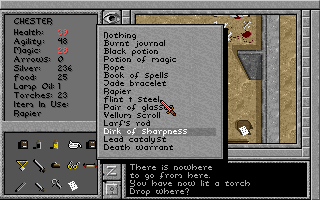 |
| A few too many things in my backpack. |
Showing the death warrant to the sheriff cleared my name, and showing it to Berrin prompted him to give me the prophecy on a vellum scroll. I read the prophecy. Larkin’s notes indicted that “most of it has already come to pass.”
And it shall come to pass that in the day, the end of all days, a Shadow will come forth from the wilderness. The Lord of the Shadows, the Bringer of Darkness, the Master of Death. At his hand, Evil will arise anew. Green fields will wither, and a plague will smite the land. Cry mothers for your children, for when you see these things, know ye that the fate of the world hangs in the Balance.
It’s probably going to turn out that Cam Tethe is the Lord of the Shadows, but it would be nice if the game had some kind of twist on the standard template, like maybe it’s me (I did kind-of come out of the wilderness). Either way, I had to get off the island. Since the ferry was broken, I turned to the only place I hadn’t explored: Larf’s tower. It sits in a ruined heap on the coast, near a graveyard where a ghost wanders. I tried talking to him, but it didn’t work.
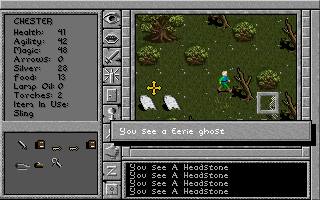 |
| Maybe later, I’ll find a “Seance” spell. |
A rope gets you into the basement of the tower, which turned out to consist of five levels. Every one is dark, so you need a light source. The game keeps track of torches as a statistic, along with food and silver, rather than as inventory items, but you need a flint and steel in your inventory to light them. An alternative is to purchase a lamp and lamp oil, the latter of which is also tracked as a statistic. It would be a waste of inventory space, I gather, to have both a lamp and flint and steel.
 |
| Arriving in the dungeon. |
The levels of Larf’s tower were full of evidence of Larf’s macabre experiments, including zombies that I had to kill. His notes indicated that he was more than a necromancer: he was a serial killer, having captured living subjects for many of his rituals. These notes also said that he eventually created an undead butler to serve him, but the creature went insane, stole something called a “translocation rod,” and hid it in a lower level of the tower. Larf was apparently making plans to destroy the creature when it attacked him in his bed at night, killing him and leaving his severed head behind.
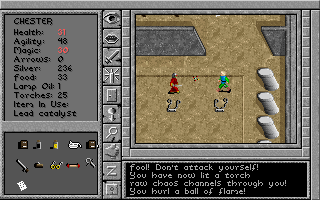 |
| Later, I killed the butler, Jeffers, with fireballs. |
This scene is graphically illustrated, and it’s worth making a note that the graphics are detailed enough that they can show rather than just tell evocative stories like this. This hasn’t been true of many games up until now, but it’s good to see it becoming more common. We’ll of course see another murder scene with the same level of gruesome detail in the upcoming Ultima VII.
 |
| The gruesome scene. |
I eventually killed the butler–the hardest creature in the game so far–with a few “Incendiere” spells. I recovered the rod, which allows transportation to the mainland when used between a couple of stones northwest of the tower. I also had the option to take Larf’s head. I have it for now, but I ‘m not sure if there’s any long-term use for it. Other treasure included a better catalyst (platinum), a magic weapon called a “Dirk of Sharpness,” and a scroll that gave me the “Inlustare” (light) spell.
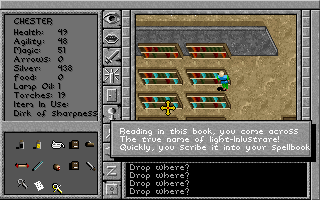 |
| Now I guess I can eschew both lamps and torches. |
I used the rod in the right location and found myself transported to the mainland. I explored a while before concluding that I was in the northern part of the map, near the town of Glade. Larkin insisted that the prophecy had to get to Silverdale, to my southeast, but I’m tempted to go to the northern tip to the town of Malice and work my way systematically down to Silverdale.
So far, it’s been an inoffensive little game, but I wonder if there was really much of a market for a “lite” RPG. Were there legions of gamers in 1992 thinking, “I’d really like to play role-playing games, but they’re just too complicated“? I guess we’ll see when we check the reviews. I can’t imagine this one will take more than three entries, but perhaps it has some tricks up its sleeve.
Original URL: http://crpgaddict.blogspot.com/2019/07/game-335-prophecy-of-shadow-1992.html

